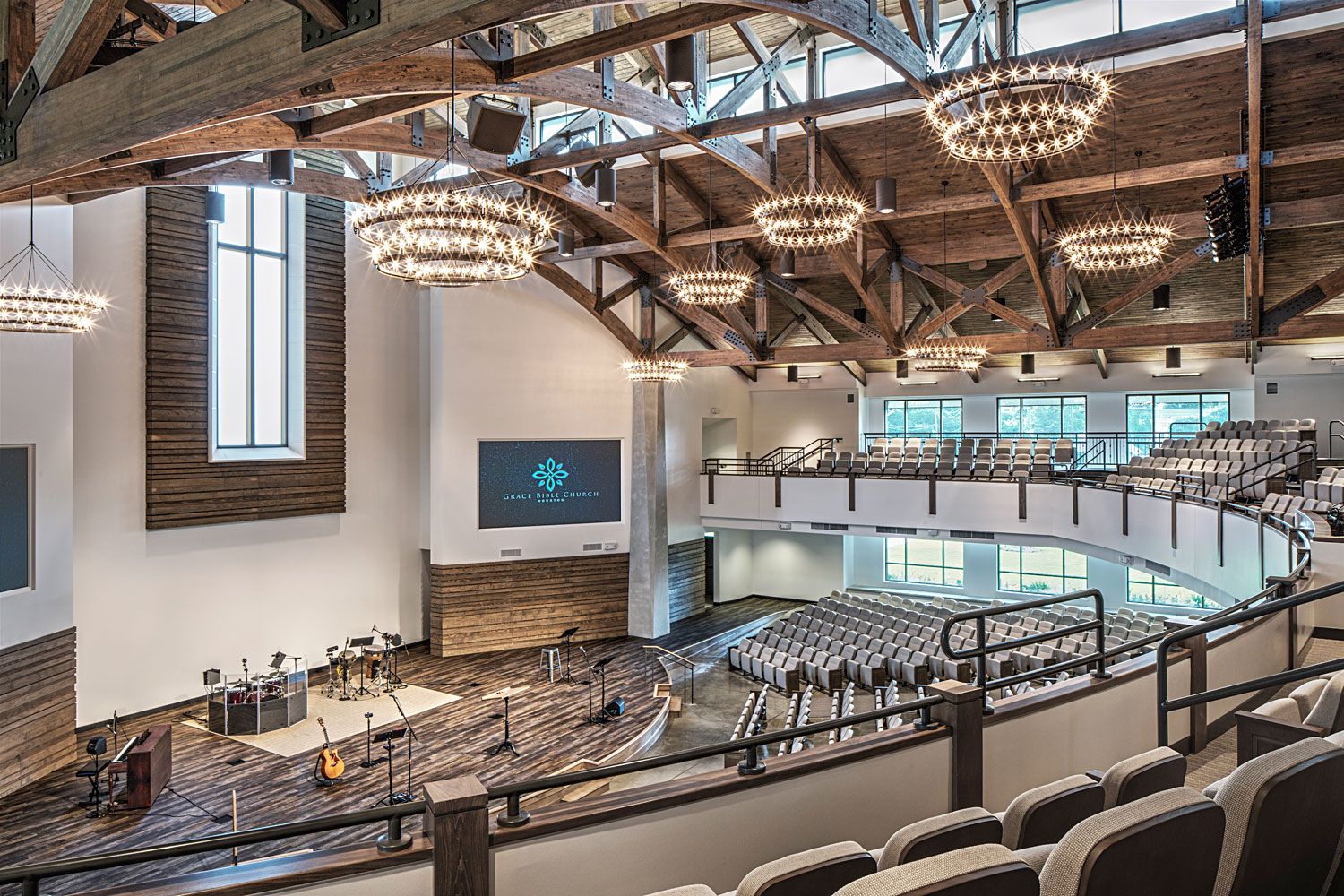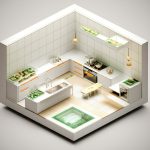Step inside a modern church, and you’ll encounter a refreshing departure from the conventional. Gone are the days of austere and uninviting spaces. Today’s churches are embracing a harmonious blend of style and functionality, creating versatile sanctuaries that resonate with a profound sense of purpose and meaning. Architects and designers are transforming traditional houses of worship into vibrant spaces that foster a deep connection to faith and community.
Church Building Interior Design
Redesigning your church’s interior goes far beyond mere aesthetics. It’s a thoughtful process of crafting a space that resonates with the congregation’s values and enhances their spiritual journey. Creating a welcoming and functional environment requires careful consideration of various elements that contribute to an enriching worship experience.
Comfort plays a vital role in fostering a sense of belonging and encouraging interaction among members. Seating arrangements that facilitate conversation and community building can transform the way people connect within the sacred space.
Flexibility is also paramount in modern church design. By creating spaces that can easily adapt to different events and activities, from traditional services to community gatherings, churches can expand their reach and cater to the diverse needs of their congregations.
Functionality ensures that the space effectively serves its primary purpose – prayer, worship, and spiritual reflection. This involves considering the flow of movement, the placement of furniture, and the overall layout to create an intuitive and welcoming environment.
Technology has become an integral part of modern church design, enhancing the worship experience and improving accessibility. Integrated sound systems, thoughtfully placed screens for displaying hymns and readings, and online platforms for virtual participation all contribute to a more engaging and inclusive experience.
Inclusivity is another crucial aspect of modern church design. Creating an environment that welcomes people of all abilities and backgrounds is essential for fostering a true sense of belonging. This includes incorporating features such as ramps, accessible restrooms, and sensory-friendly spaces to ensure that everyone feels comfortable and valued.
Sustainability reflects a commitment to environmental stewardship, a value often embraced by faith communities. Utilizing eco-friendly materials and practices in church construction and design minimizes the environmental impact and promotes a sense of responsibility towards God’s creation.
Symbolism, deeply rooted in faith traditions, plays a significant role in creating a meaningful atmosphere. Incorporating design elements that reflect the congregation’s beliefs and values adds layers of meaning to the space, enhancing the spiritual experience. Stained glass windows depicting biblical scenes, for example, not only add visual interest but also serve as powerful reminders of faith.
| Element | Description |
|---|---|
| Functionality | Making sure the space serves its purpose – prayer, singing, gathering |
| Technology | Integrating sound systems, screens, and lighting for a better experience |
| Flexibility | Designing spaces that can be easily adapted for various events |
| Inclusivity | Creating a welcoming environment for people of all abilities and backgrounds |
| Sustainability | Using eco-friendly materials and practices |
| Symbolism | Incorporating meaningful design elements that reflect faith values |
Modern church design transcends mere aesthetics; it’s about crafting welcoming, adaptable, and inspiring spaces where people can connect with their faith and each other.
What are the Key Elements of Inspiring Church Interior Design?
Beyond the fundamental considerations, certain elements elevate church design from ordinary to extraordinary. These elements weave together to create a tapestry of functionality, symbolism, and aesthetic appeal, transforming the church into a truly inspiring sacred space:
Making it Work: Functionality and Accessibility for Everyone
A church should be a welcoming space for everyone. Imagine a family with a stroller navigating a crowded entrance or an elderly member struggling to access the sanctuary. Functionality and accessibility are paramount, going beyond mere compliance with regulations. It’s about creating an environment where everyone feels comfortable and included.
Think about the flow of movement within the space. Are walkways wide enough to accommodate wheelchairs and walkers? Are there designated areas for families with young children? Is the signage clear and easy to read? By addressing these practical considerations, churches can create a welcoming and inclusive environment for all.
Speaking to the Soul: Symbolism and Aesthetics
Churches are imbued with symbolism, reflecting the congregation’s faith and history. Architectural details, artwork, and even the choice of materials can convey deeper meaning, adding layers of richness to the worship experience.
Consider the use of light. Natural light streaming through stained glass windows can create a sense of awe and wonder, while strategically placed artificial lighting can highlight architectural features and create a warm and inviting ambiance.
Treading Lightly: Embracing Sustainability
In an era of increasing environmental awareness, churches have an opportunity to demonstrate their commitment to stewardship by incorporating sustainable practices into their design and construction. This not only benefits the planet but also serves as a powerful testament to the congregation’s values.
Imagine a church with solar panels on the roof, harnessing the power of the sun to generate electricity. Picture rainwater harvesting systems that collect and utilize rainwater for irrigation or plumbing. These sustainable choices not only reduce the church’s environmental footprint but also set a positive example for the community.
Setting the Mood: Lighting and Seating
Lighting plays a crucial role in setting the mood of a space. Imagine a sanctuary bathed in soft, natural light filtering through stained glass windows, creating an ethereal and serene atmosphere. Conversely, a brightly lit fellowship hall with track lighting can foster a more energetic and social atmosphere.
Seating should balance comfort and functionality. Comfortable seating allows congregants to focus on the service without distractions. Consider pews with cushions, individual chairs with padding, or even flexible seating arrangements that can be reconfigured for different events.
Thinking Outside the Box: Unique Insights
Modern church design encourages innovation and creativity. Incorporating unique touches that reflect the congregation’s personality and values can transform the space into a truly memorable and meaningful environment.
A Feast for the Senses: Sensory Design
Engaging all the senses can elevate the worship experience to new heights. Consider the use of aromatherapy to infuse the sanctuary with calming scents or the incorporation of water features that create a soothing ambiance.
Building Community: Interactive Spaces
Creating designated spaces for interaction and fellowship can strengthen the sense of community within the church. Think about incorporating a cozy coffee bar where people can connect after service or a dedicated space for children to play and learn together.
Embracing the Future: Innovative Materials and Technology
Modern materials and technology can enhance both the functionality and aesthetic appeal of a church. Imagine interactive displays that share the church’s history and upcoming events or sound-dampening materials that improve acoustics during services.
Honoring the Past: Cultural Context
Every church has a unique history and cultural context that should be honored in its design. A church in a historic neighborhood might incorporate architectural elements from the surrounding buildings, while a church in a diverse community might feature art and design elements from different cultures. This thoughtful approach creates a space that feels authentic and relevant to the community it serves.
How Can Church Interior Design Enhance Worship and Community?
Church interior design has a profound impact on the way people experience worship and connect with their community. Thoughtful design choices can create a welcoming and inspiring environment that fosters spiritual growth and deepens the sense of belonging.
Warm and Welcoming: A welcoming atmosphere instantly puts visitors and members at ease, making them feel comfortable and accepted. This can be achieved through the use of warm colors, comfortable seating, and open layouts that encourage interaction.
Sensory Experience: Engaging all the senses can create a more immersive and meaningful worship experience. Soft lighting, calming scents, and pleasing textures work together to create an atmosphere of peace and reverence.
Meaningful Design: Incorporating symbolic elements and architectural details that reflect the congregation’s faith can deepen their connection to their spirituality. Stained glass windows, religious icons, and even the architectural style itself can tell the story of faith and inspire a sense of awe.
Flexible Functionality: Designing spaces that can adapt to various events and activities accommodates the diverse needs of the congregation and encourages participation. Movable seating, retractable walls, and multi-purpose rooms allow the church to transform from a sanctuary into a fellowship hall, a classroom, or a concert venue, fostering a sense of community and shared purpose.
Tech Integration: Seamless technology integration enhances accessibility and engagement, making worship more inclusive and meaningful for all. A well-designed sound system ensures that everyone can hear the service clearly, while strategically placed screens can display hymns, scripture readings, and visual elements that complement the message. Online platforms extend the church’s reach, allowing members who are unable to attend in person to participate virtually.
Exploring Different Styles of Church Building Interior Design
Choosing the right interior design style is an important decision that reflects the church’s identity, values, and vision.
Key Takeaways: A Sneak Peek at What’s in Store
- Modern Design: Clean lines, open spaces, and an abundance of natural light characterize this style, emphasizing functionality and creating a welcoming ambiance.
- Gothic Revival: This style harks back to medieval cathedrals, featuring towering arches, intricate stonework, and colorful stained-glass windows that inspire a sense of awe and grandeur.
- Art Deco: Bold geometric designs, luxurious materials like marble and velvet, and gleaming metallic accents define this style, exuding an air of sophistication and glamour.
- Mediterranean Revival: Characterized by whitewashed walls, terracotta tiles, exposed wooden beams, and arched doorways, this style evokes the warmth and charm of Mediterranean architecture.
- Contemporary Design: This style embraces innovation, incorporating unique architectural elements, sustainable materials, and an abundance of natural light to create inspiring and welcoming spaces.
Let’s Explore the Styles in More Detail:
Modern Design: Where Simplicity Meets Functionality
Modern church design embraces simplicity and functionality, creating spaces that feel open, airy, and welcoming. Natural light takes center stage, with large windows and skylights illuminating the interior. The emphasis is on creating a sense of community and connection, with flexible seating arrangements and open floor plans that encourage interaction.
Gothic Revival: A Journey Back to Grandeur
Stepping into a Gothic Revival church is like taking a step back in time. This style, popularized in the 19th century, draws inspiration from medieval European cathedrals. Soaring vaulted ceilings, pointed arches, intricate stonework, and stained-glass windows create a sense of awe and grandeur, evoking a sense of the divine.
Art Deco: Embracing Elegance and Glamour
Art Deco emerged in the 1920s and 1930s, celebrating luxury, glamour, and geometric designs. Art Deco churches often feature bold geometric patterns on walls, floors, and stained-glass windows. Rich materials like marble, polished wood, and chrome accents add to the sense of opulence and sophistication.
Mediterranean Revival: An Oasis of Warmth and Welcome
Mediterranean Revival churches exude warmth, charm, and a connection to nature. This style features whitewashed walls, terracotta roofs, arched windows and doorways, and courtyards with fountains, creating an inviting and serene atmosphere reminiscent of the Mediterranean region.
Contemporary Design: Breaking New Ground
Contemporary church design is constantly evolving, embracing innovation and pushing the boundaries of traditional church architecture. This style often features unconventional shapes, sustainable materials, and a focus on creating a connection to the outdoors.
Conclusion: Finding the Perfect Style for Your Spiritual Home
Choosing the right interior design style for your church is a deeply personal journey. It’s about reflecting your congregation’s identity, values, and vision for the future. Whether you’re drawn to the timeless elegance of Gothic Revival, the modern simplicity of minimalist design, or the warmth of Mediterranean Revival, there’s a perfect style out there waiting to transform your church into a truly inspiring and welcoming sacred space.
For more inspiration on interior design:
- For a historic look at home interior, check out Frank Lloyd Wright’s interior design.
- If you want to enhance the look and privacy of a room, then take a look at our guide to interior door design.
- Finally, if you’re looking for something more commercially tailored, like interior design for a salon, then we have it covered.
- White Tile Backsplash Kitchen: A Classic and Clean Design - November 17, 2025
- Backsplash For White Cabinets: Choosing The Right Kitchen Style - November 16, 2025
- White Kitchen Backsplash Ideas For a Timeless, Stylish Update - November 15, 2025










